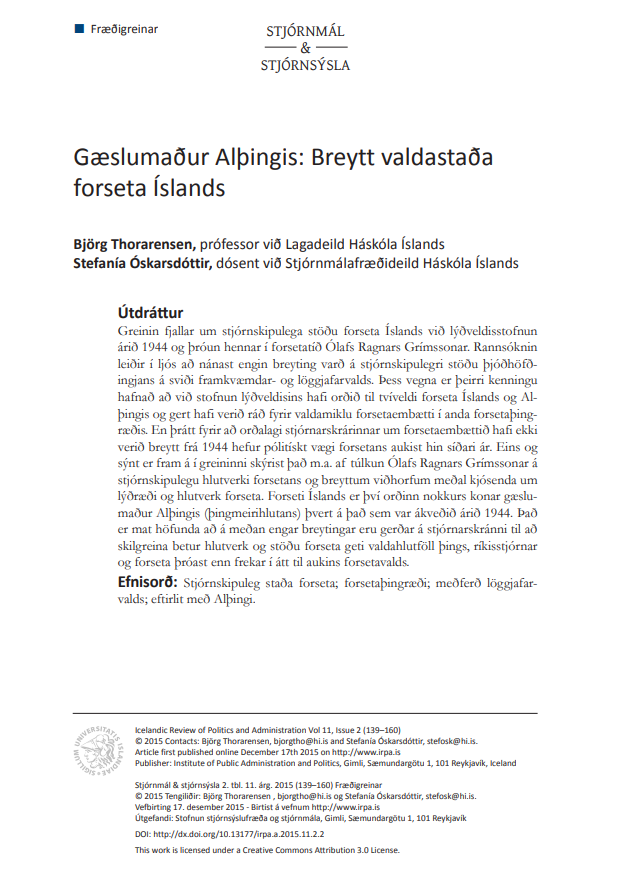Titill:
Gæslumaður Alþingis: Breytt valdastaða forseta Íslands
Höfundur:
Björg Thorarensen og Stefanía Óskarsdóttir
Tilvísun:
Tilvísun: Björg Thorarensen og Stefanía Óskarsdóttir. 2015. „Gæslumaður Alþingis: Breytt valdastaða forseta Íslands.“ Stjórnmál og stjórnsýsla 11 (2): 139-160. doi: 10.13177/irpa.a.2015.11.2.2.
Úrdráttur:
Greinin fjallar um stjórnskipulega stöðu forseta Íslands við lýðveldisstofnun árið 1944 og þróun hennar í forsetatíð Ólafs Ragnars Grímssonar. Rannsóknin leiðir í ljós að nánast engin breyting varð á stjórnskipulegri stöðu þjóðhöfðingjans á sviði framkvæmdar- og löggjafarvalds. Þess vegna er þeirri kenningu hafnað að við stofnun lýðveldisins hafi orðið til tvíveldi forseta Íslands og Alþingis og gert hafi verið ráð fyrir valdamiklu forsetaembætti í anda forsetaþingræðis. En þrátt fyrir að orðalagi stjórnarskrárinnar um forsetaembættið hafi ekki verið breytt frá 1944 hefur pólitískt vægi forsetans aukist hin síðari ár. Eins og sýnt er fram á í greininni skýrist það m.a. af túlkun Ólafs Ragnars Grímssonar á stjórnskipulegu hlutverki forsetans og breyttum viðhorfum meðal kjósenda um lýðræði og hlutverk forseta. Forseti Íslands er því orðinn nokkurs konar gæslumaður Alþingis (þingmeirihlutans) þvert á það sem var ákveðið árið 1944. Það er mat höfunda að á meðan engar breytingar eru gerðar á stjórnarskránni til að skilgreina betur hlutverk og stöðu forseta geti valdahlutföll þings, ríkisstjórnar og forseta þróast enn frekar í átt til aukins forsetavalds.
Abstract:
The article focuses on the constitutional role of the president of Iceland when the republic was established in 1944, and the evolution of this role during the time Ólafur Ragnar Grímsson has been in office. The study shows that the creation of a republic involved hardly any changes in the constitutional role of the head of state neither in regard to executive nor legislative powers. Thus the authors reject the theory that the creation of a republic introduced a dual authority structure, consisting of Althingi and a powerful president, which characterizes semi-presidentialim. However, despite the fact that the text of the constitution, regarding the presidency, has not been changed since 1944, the political importance of the president has increased in recent years. This is mainly the result of Ólafur Ragnar Grímsson´s interpretation of the constitutional role of the president, as well as changes in public attitudes regarding democracy and the role of the president. According to this interpretation, the president acts as Althingi´s keeper who acts as a check on the majority rule of Althingi contrary to what was decided in 1944. The authors maintain that in the absence of formal constitutional changes, were the role of the presidency is better defined; the power of the president vis-à-vis the cabinet and parliament may continue to grow.


